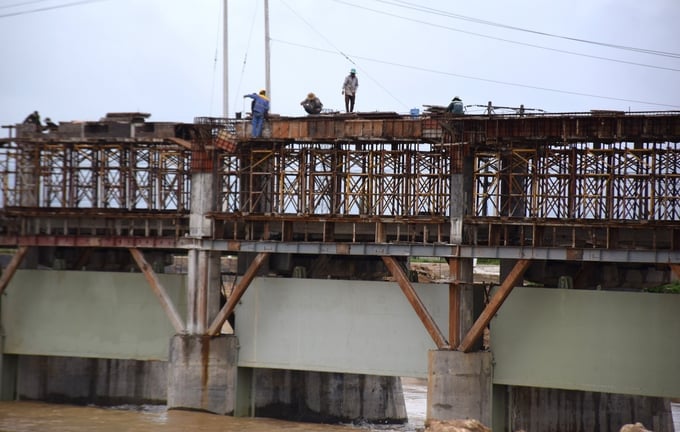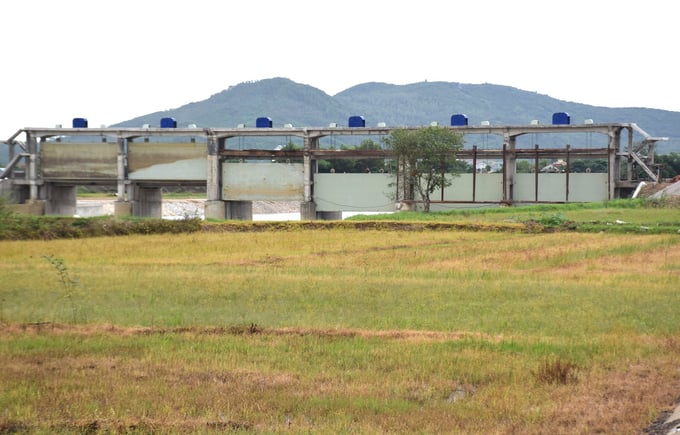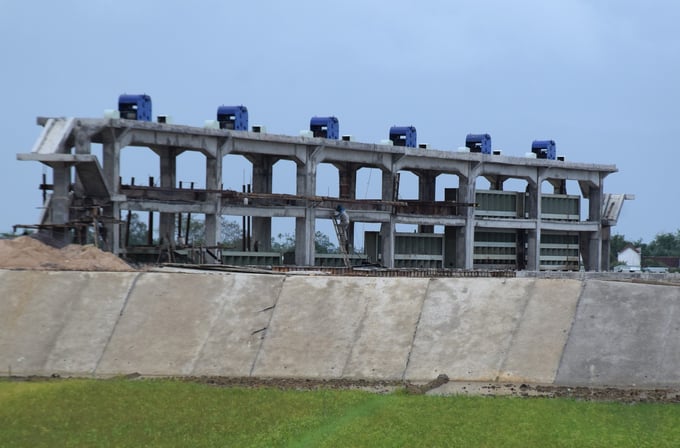June 19, 2025 | 00:23 GMT +7
June 19, 2025 | 00:23 GMT +7
Hotline: 0913.378.918
June 19, 2025 | 00:23 GMT +7
Hotline: 0913.378.918
By implementing the program to reinforce canal systems towards new rural construction from 2021 to 2025, Binh Dinh province has successfully fortified 79 kilometers of various types of canals in 2022. Consequently, the program has increased the area of agricultural land with active irrigation from structures across the province to 84.44% of the total production area.
To date, Binh Dinh province has 106 communes (or 93.8% of the total number of communes) meeting the level 3 irrigation criteria according to the Ministry of Agriculture and Rural Development's New Rural Development Standard for 2021 to 2025. Accordingly, communes meeting the level 3 criteria for "irrigation and disaster prevention and control" must fulfill the following requirements: a proactive irrigation and water consumption rate for agricultural land of at least 90%; at least one effective and sustainable grassroots irrigation organization; a progressive and water-saving irrigation rate for the local main crops in accordance with the regulations imposed by the Provincial People's Committee; all small-scale irrigation and internal canal irrigation structures must be maintained annually; conduct regular audits and employ control over sources of wastewater discharge into irrigation structures; ensure proactive disaster prevention and control following the "4 on-site" principle.
With the aim of providing a stable supply of irrigation water for local agricultural production to enhance productivity and crop yields, and contribute to meeting criterion 10 regarding the average income per capita in new rural construction, Binh Dinh province has also utilized multiple funding sources for the repairing and upgrading of its numerous irrigation structures.
Namely, the province is upgrading six irrigation dams to promote safe operation, with a fous on enhancing disaster prevention and control measures during the flood season.

The Thanh Hoa 1 Dam is currently undergoing repairs and upgrades in Nhon Hoa Ward, An Nhon Town, Binh Dinh. Photo: V.D.T.
According to Mr. Ho Nguyen Si, Deputy Director of the Project Management Board for Agriculture and Rural Development in Binh Dinh province, the Board was assigned by the Provincial People's Committee to implement the investment and construction of 19 project categories, including transitional projects and newly initiated projects, with a total capital of 1,190 billion Vietnamese. Accordingly, the Board is responsible for the implementation of various dam projects including Thanh Hoa 1, Thuan Hat, Thong Chin, Cay Bua, Go Cham, Go Dau, and a portion of the Tan An - Da Da irrigation system.
"The aforementioned dams are being repaired and upgraded to enhance the capacity for supplying irrigation water to local agricultural production and supplying raw water for domestic water plants, and to improve flood drainage capacities, thereby ensuring effective disaster prevention and control during the flood season," explained Mr. Si.
After observing the ongoing repairs and upgrades at the Thanh Hoa 1 Dam in Nhon Hoa ward, An Nhon town, we noticed that the new dam is situated approximately 5.8 meters downstream from the old dam. The structure has a total width of 107.2 meters with 7 deep sluice gates, each measuring 12 meters in width. According to Mr. Si, upon completion, the dam will be operated using flat steel gate valves, controlled by an electric winch system. Two spillway compartments are arranged on either sides of the dam (each with a width of 4 meters), and a left spillway channel with a width of 16.2 meters is also planned. Additionally, a working bridge is positioned at the top of the dam, serving both functional and transportation purposes.

Workers from Construction Joint Stock Company 47 carrying out the construction of the Thanh Hoa 1 Dam. Photo: V.D.T.
Furthermore, the Thanh Hoa 1 Dam Project has received investments to construct water intake culverts on either shoulder of the dam, an upper dam embankment, and an electrical system. Additionally, the project will install rainfall and water level measuring devices, and surveillance cameras to facilitate automation in the management and operation processes.
"The total investment for the construction of the new Thanh Hoa 1 Dam is approximately 95 billion Vietnamese dong, sourced from the mid-term central support funds for 2021 to 2025 and the provincial budget," stated Mr. Ho Nguyen Si.
Sharing the aforementioned funding sources, the Project Management Board for Agriculture and Rural Development in Binh Dinh provine will also invest in the construction of the new Thuan Hat Dam located in the Nhon Thuan area, Nhon Thanh ward, An Nhon town. The structure will have a width of 46 meters with 3 deep sluice gates in the middle (each with a width of 8 meters), operated by flat steel gate valves and controlled by an electric winch system. Two spillway compartments are arranged on either sides, each with a width of 22 meters. A working bridge is positioned at the top of the dam to serve both functional and transportation purposes.
Mr. Nguyen Van Nghia, a 46-year-old resident from Nhon Thuan ward, Nhon Thanh town, An Nhon town shared his thoughts on the newly constructed dams, "Every year during the flood season, water quickly overflows the dam, submerging most crops below, with the most severe damage occurring to ornamental flower fields. The new Thuan Hat Dam and its modern operation will improve flood regulation capacities, store water to serve agricultural production, and maintain stability in the groundwater flow. Moreover, the project provide wells in the area with ample water, to comfortably supply daily activities."
According to Mr. Nguyen Van Tanh, Director of the Water Works Exploitation Company Limited in Binh Dinh province, the majority of dams in the Tan An - Da Da irrigation system were built approximately 50 to 60 years ago. The level of investment at that time did not meet the requirements due to a shortage of materials, coupled with limited construction expertise and technology. As a result, over their long period of operation, these dams have deteriorated, fallen into disrepair, and their operational stability has been compromised.
For example, the Thanh Hoa 1 Dam, built in 1982 on the Tan An River, a main branch of the Kon River, is tasked with irrigating nearly 3,726 hectares of agricultural land in the communes of Phuoc Hiep, Phuoc Loc, Phuoc Nghia, Phuoc An, Phuoc Son, Phuoc Hoa, Phuoc Thuan in Dieu Tri town, and Tuy Phuoc town in Tuy Phuoc district. It also diverts water to the Ha Thanh River to serve the wards of Tran Quang Dieu, Nhon Binh, and Nhon Phu in Quy Nhon city. Thanh Hoa 1 Dam has 35 gates, each with a width of 2 meters, operated manually with boards. This dam has since deteriorated, with a limited discharge capacity that cannot guarantee effective flood drainage. Moreover, due to nature of manual operation, accidents often occur on the dam, especially during early and late flood seasons.

Thong Chin Dam undergoing repairs and upgrades in Phuoc Loc commune, Tuy Phuoc district, Binh Dinh. Photo: V.D.T.
According to Mr. Tanh, workers in the past had to laboriously contend with the gate valves in order to open or close the dam gates. Accordingly, two workers stood on opposite ends of the board, using long-handled sticks to reach down from the top of the dam, prying the iron hooks used to lock the boards together. The workers must then laboriously pull the boards to the top. The process of opening the 35 dam gates required a considerable amount of time. In cases of sudden flooding from upstream, the dam was unable to regulate the water in time. The boards often failed to fit tightly together, leaving gaps in the middle. As a result, workers were forced to fill these gaps with soil or sand to prevent water leakage, making it challenging to regulate water flow.
"Modernizing irrigation structures makes management and operation much more convenient. The traditional dam boards have been replaced with flat steel gate valves which can be opened and closed by an electric winch system. With a press of a button, and the gates can move up or down very quickly. When these new dams go into operation, workers will no longer have to risk accidents standing on the dam trying to open boards in rainy and flood conditions. During the 2017 flood season, a regrettable incident occurred at the Thanh Hoa Dam where a worker slipped and fell into the rushing floodwaters while operating the dam, resulting in a tragic loss of life," shared Mr. Nguyen Van Tanh.

Binh Dinh province is upgrading six irrigation dams to promote safe operation and to enhance disaster prevention and control measures during the flood season. Photo: V.D.T.
"Binh Dinh province will continue to implement an additional 12 projects under the program to repair and upgrade damaged and downgraded water reservoirs from 2021 to 2025. These projects include the Hai Nam, Hoc Thanh reservoirs in Tay Son district; Suoi Cau reservoirs in Van Canh district; Da Ban, Gian Tranh, Nha Ho reservoirs in Phu My district; Cay Dieu, Hoc Hao, Dong Quang reservoirs in Hoai An district, Cay Thich, Da Vang reservoirs in Tuy Phuoc district, and Chanh Hung reservoir in Phu Cat district.
"These water reservoirs will be equipped with monitoring devices to ensure the safety of the reservoirs, improve design functions, and operating conditions of the dams. Additionally, this initiative aims to minimize the risk of dam failure, protect the communities and properties downstream of the projects, ensure stable long-term irrigation for agricultural land, and contribute to the development of sustainable agriculture and new rural construction," emphasized Mr. Ho Nguyen Si.
Translated by Nguyen Hai Long
![Turning wind and rain into action: [9] Digitizing hydrometeorological data in response to climate change](https://t.ex-cdn.com/nongnghiepmoitruong.vn/608w/files/news/2025/06/17/z6704423696987_15fd32ffc26d590d204d520c9dac6786-nongnghiep-165943.jpg)
(VAN) Farmers have begun accessing hydrometeorological applications to adjust their cropping schedules, aiming to ensure productivity and adapt to climate change.
![Turning wind and rain into action: [8] Real-time salinity detection and early warning technology](https://t.ex-cdn.com/nongnghiepmoitruong.vn/608w/files/news/2025/06/17/z6704423696987_15fd32ffc26d590d204d520c9dac6786-nongnghiep-151127.jpg)
(VAN) Thanks to the integration of modern hydrological-hydraulic models, remote sensing technologies, and artificial intelligence, the accuracy of hydrological forecasting has significantly improved.
![Turning wind and rain into action: [7] Early disaster warnings help marine farmers minimize losses](https://t.ex-cdn.com/nongnghiepmoitruong.vn/608w/files/news/2025/06/17/z6704423696987_15fd32ffc26d590d204d520c9dac6786-nongnghiep-142942.jpg)
(VAN) In recent years, thanks to early disaster warnings and forecasting, marine farmers in Khanh Hoa province have been able to reduce risks and losses, thereby improving production efficiency.
![Turning wind and rain into action: [6] ‘Four on-the-spot’ disaster management software](https://t.ex-cdn.com/nongnghiepmoitruong.vn/608w/files/news/2025/06/17/e5a48259d6a262fc3bb3-nongnghiep-183800.jpg)
(VAN) By simply activating the scenario on the disaster management software, the relevant authorities immediately know how many households need to be evacuated, where to evacuate them to, and by what means of transportation…
![Turning wind and rain into action: [5] Hue applies modern technology in disaster forecasting](https://t.ex-cdn.com/nongnghiepmoitruong.vn/608w/files/news/2025/06/17/z6704423696987_15fd32ffc26d590d204d520c9dac6786-nongnghiep-093938.jpg)
(VAN) In Hue city, modern technology has recently been applied in meteorological and hydrological forecasting and warning, helping to reduce the damage caused by natural disasters.

(VAN) A cutting-edge farming technique being implemented on an experimental ranch in Arizona's Sonoran Desert has already saved a billion gallons of water over five years, according to Civil Eats.

(VAN) Poultry and pig production and the environment can be boosted through enhanced water technology, according to new research.